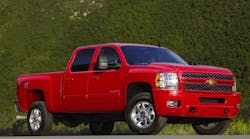For time out of mind, “capability” – which incorporates metrics such as horsepower, torque, reliability, durability, and longevity – took the top slot on the list of attributes demanded by commercial users of pickup trucks.
Now, however, fuel economy is becoming far more critical among such customers, report pickup OEMs – which is sparking all sorts of changes in this light truck segment.
“Fuel economy was also a concern but a distant one because the first priority for these pickup users was to get a tool to get the job done,” Dan Tigges, product manager for full size trucks at General Motors, told Fleet Owner. “After that came the life cycle cost of the vehicle, which included factors such as initial purchase price, fuel economy, etc.”
Now, however, the fuel economy portion of that life cycle cost equation is taking on far greater weight; to the point where commercial operators are actually selecting different models compared to past preferences in order to gain better fuel efficiency.
“What we continue to hear is that customers are taking the fuel economy piece up a big notch within the overall cost of ownership structure – and we’re seeing a lot of movement down the model chain as a result,” explained Brian Raithsburg, F-Series Super Duty marketing manager for Ford Motor Co.
“We’re seeing fleets move from an F-450 down to an F-350 or F-250 – even an F-150 – to gain a lighter chassis with better fuel economy that can still get the job done,” he said. “That’s not just happening to us; it’s happening industry wide.”
It’s happening in part because OEMs are also increasing the capability of their lighter models – giving them more horsepower and torque, thus resulting in more payload and towing capacity – while retaining fuel-sipping characteristics.
Take the new 2013 model Ram 1500 pickup rolled out by Chrysler’s Ram Trucks division back in April this year. It features a redesigned 3.6-liter Pentastar V6 engine that cranks out 305 hp and 269 ft.-lbs. of torque – 42% and 13% more, respectively, than the 3.7-lter V6 it replaces.
Yet, when combined with Ram’s new TorqueFlite 8 eight-speed automatic transmission, the 2013 Ram 1500 offers a 20% improvement in fuel economy as well, noted Bob Hegbloom, director of the Ram truck division.
Further, Ram’s optional 5.7-liter V-8 HEMI, equipped with what Ram calls “fuel saver technology” and variable-valve timing, cranks out 395 hp and 407 lb.-ft. of torque, yet offers 10% better fuel economy than the 2012 Ram V-8 powertrain it replaces, noted Lucas Frank, head of Ram Truck product planning for Chrysler.
That extra power also gives the 2013 Ram 1500 heavy-duty tradesman model, which automatically comes spec’d with the V-8 package, 11,500 pounds worth of towing capacity and 3,125 pounds of payload, he said.
As a result, Hegbloom is seeing customers “downshift” from heavier – and more fuel consuming – 1-ton and ¾-ton pickups into the ½-ton Ram segment because they aren’t sacrificing much, if any, capability to gain better fuel economy.
“The cost of fuel is now so extremely important within the total cost of operation or ‘TCO’ calculation if you will for these truck users,” he explained to Fleet Owner.
“This shift is of course application specific – these trucks are first and foremost viewed as ‘tools’ by these users for their businesses; it’s got to deliver,” he explained. “But today, fuel economy is a primary factor in that ‘tool selection’ process. It’s become one of the key buying requirements in this segment.”
“Fuel economy has definitely crept up on everyone’s list,” added Joyce Mattman, director for GM commercial products and specialty vehicles.
“The interesting thing is that all vehicles in this segment have more power and capability versus the past, so the opportunity is greater than before to downsize in order to gain better fuel efficiency,” she noted. “And when a fleet downsizes, they also typically get a less expensive truck as well. That’s two wins – less cost and better fuel economy – if they can do it.”



